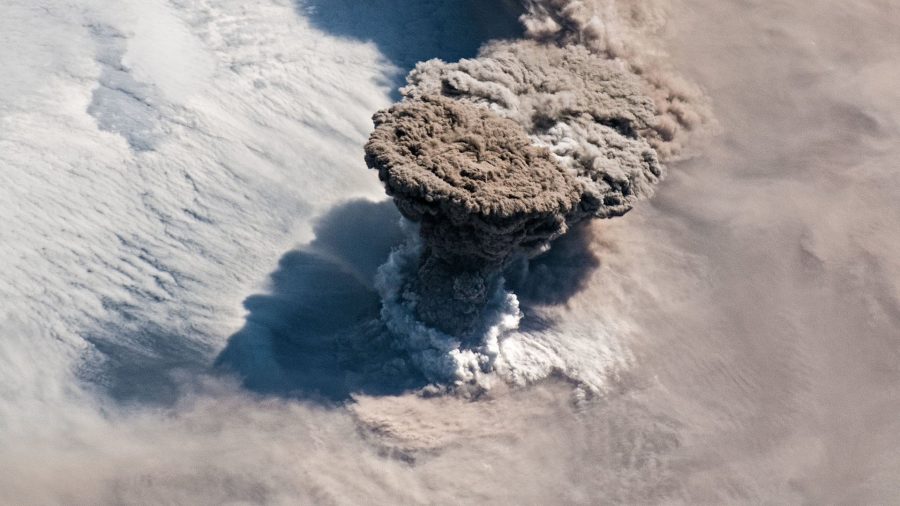The Raikoke volcano rarely ever erupts, but when it does, it goes big.
Astronauts and several satellites captured images of the volcanic eruption from space on June 22. The plume from the eruption may have reached an altitude of 8 miles high, according to the Volcanic Ash Advisory Centers in Tokyo and Anchorage.
Raikoke is an uninhabited volcanic island in the northwest Pacific Ocean, off the coasts of Russia and Japan. The volcano is not nearly as active as many of its neighboring islands on the Kamchatka Peninsula.
The most recent Raikoke eruption was in 1924 and before that in 1778, according to a release from NASA’s Earth Observatory.
The volcanic ash and gas rises in a narrow column and spreads out in the upper part of the plume in the shape of an umbrella, as seen in images taken by astronauts at the International Space Station.

“What a spectacular image,” Simon Carn, a volcanologist at Michigan Technological University, said in a NASA press release. “It reminds me of the classic Sarychev Peak astronaut photograph of an eruption in the Kuriles from about ten years ago.”
According to NASA, the ring of clouds at the base of this column appear to be water vapor.
Volcanologists keep a close eye on plumes that reach this level of the stratosphere, as they can have a large effect on both aviation and climate.
Volcano eruption seen from the space station. pic.twitter.com/ALaUOQZgSr
— Antonio Paris (@AntonioParis) April 1, 2019
Photo of Huge ‘Lava Dome’ in Hawaii Goes Viral
The unprecedented Mauna Ulu eruption of Kilauea Volcano in Hawaii led to some spectacular imagery a few decades back. Not only was it the longest eruption on record at the time, it was also easily accessible for the public to view. This combination of factors resulted in some amazing photography.
The Mauna Ulu eruption began in 1969 and flowed fairly consistently until 1974, lasting a total of 1,774 days (just shy of five years). It was the longest-lasting and most voluminous eruption in 2,200 years, according to the U.S. Geological Society.


The volcano spewed some 350 million cubic meters (approx. 458 million cubic yards) of lava—that’s enough molten rock to fill a colossal 140,000 Olympic-size swimming pools, LiveScience reported.
An observation platform was raised for the public to view the spewing lava lake in the crater, the USGS said. In 1969, some stunning pictures were taken, one of which was posted by the USGC on social media.
A fountain of lava continually gushed and spilled into the ocean 7.5 miles away for several days, from Oct. 10 to Oct. 13 of that year. The photo, credited to J.B. Judd, shows an incredible, symmetrical “dome” of lava spewing some 65 feet into the air during the eruption. The dome was one of 12 separate fountaining events that occurred that year.
Lava domes are formed by “viscous” magma that piles up around the vent of the volcano, according to Oregon State University.
USGS wrote on Twitter: “Dome fountain of episode 10, October 10–13, 1969, eruption of Kilauea Volcano. Symmetrical dome fountains such as this are rare.”
Dome fountain of episode 10, October 10–13, 1969, eruption of Kilauea Volcano. This dome fountain is about 20 m (65 ft) high. Symmetrical dome fountains such as this are rare. #Tbt #HI @Volcanoes_NPS pic.twitter.com/sKSQaVINKs
— USGS (@USGS) March 29, 2018

“Fountaining” usually happens when gas bubbles form and expand within an isolated vent in a lava fissure, causing a jet of lava to spray into the air. Sixty-five feet seems high, yet fountains typically range anywhere from 30 feet to 330 feet; some spew spectacularly as high as 1,640 feet (half a kilometer) or more.
From the photograph, the lava dome appears to be erupting in the water, but the “waves” shown in the photo are actually ripples of lava—not water.
Since the record-setting eruption of Mauna Ula ended, another eruption has claimed the title for longest-lasting. A volcanic vent on Kilauea’s east rift zone, Pu‘u ‘Ō‘ō eruption started in 1983 and has continued since then. Yet, unlike Mauna Ula, Pu‘u ‘Ō‘ō is much less accessible for the public.
“[Pu‘u ‘Ō‘ō] ranks as the longest and most voluminous known outpouring of lava from Kīlauea Volcano’s East Rift Zone in more than 500 years,” USGS said. “Lava fountains and flows have profoundly altered the landscape and repeatedly challenged residents with lava inundation.”


Michael Wing contributed to this report.
![]()


